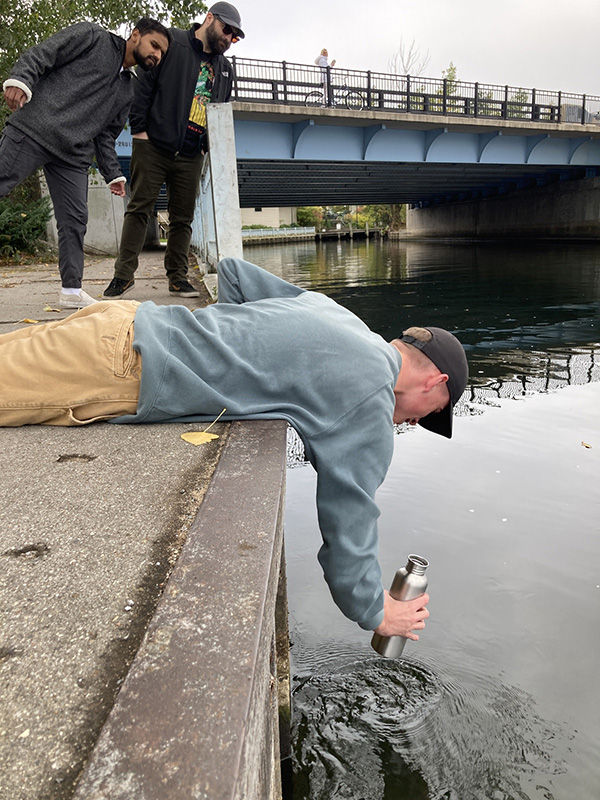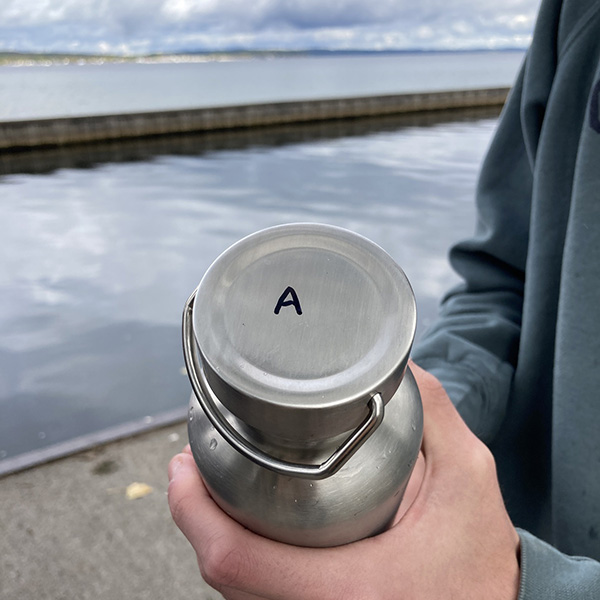Success Story: Latest freshwater research joins NMC’s repertoire
October 18, 2023
 NMC Freshwater Studies program student Kyle Warnes collects a water sample from the mouth of the Boardman/Ottaway river.NMC students have added a new first for freshwater research to a lengthy track record this semester, even as the results are creating cause for concern.
NMC Freshwater Studies program student Kyle Warnes collects a water sample from the mouth of the Boardman/Ottaway river.NMC students have added a new first for freshwater research to a lengthy track record this semester, even as the results are creating cause for concern.
Biology instructor Nick Roster’s students are sampling the Boardman/Ottaway River for microplastics. He believes it’s the first time the river’s been studied for these particles, which have relatively recently joined a lengthy list of threats to the watershed. The first round of samples showed microplastics present in 23 of 24 sample sites spread from Kalkaska to the mouth of the river at West Grand Traverse Bay.
“The students are excited because they found it, but we’re depressed because they found it,” Roster said. “Emerging pollutants are all a concern, but we have no idea of how big a concern they should be.” Their research will establish a baseline for the Boardman/Ottaway.
In addition, they’re gaining experiential learning, which NMC seeks to offer to every student in its strategic plan.
“NMC’s really great at this type of class. All three of my classes are in the field,” said Dylan Frey, 24, a Freshwater Studies student in Roster’s class.
“The research portion I love,” agreed classmate Kaylin Severance, 20. “I’m planning to go into medicine, and research is such a big aspect of that.”
Last week, Severance, Frey and their classmates were at the mouth of the river, where it empties into West Grand Traverse Bay under Grandview Parkway, pulling a sample to take back to campus and analyze. Roster held the feet of Kyle Warnes, 19, who stretched out on the pavement next to the water and scooped one liter into a stainless-steel bottle.
 The students were beginning their second round of samples. Sampling will continue monthly in November and December. Back in the classroom they’ll analyze the samples and begin to discern what the results mean. Microplastics are defined as less than five millimeters. The sampling has turned up concentrations ranging from 14 pieces per liter to hundreds.
The students were beginning their second round of samples. Sampling will continue monthly in November and December. Back in the classroom they’ll analyze the samples and begin to discern what the results mean. Microplastics are defined as less than five millimeters. The sampling has turned up concentrations ranging from 14 pieces per liter to hundreds.
“I didn’t think there was going to be that much at all,” Frey said. “Realizing we have a plethora of microplastics is really disappointing.”
“It’s quite shocking,” agreed Severance, of Kalkaska. “A portion of that river runs behind my house. I’ve been in that water since I was young.”
Ingested microplastics bioaccumulate, Roster said, with the impact increasing up the food chain. The forever chemicals can break down further into nanoplastics, and trigger physical effects.
“Part of our research will be looking at fish,” Roster said. Fish collected from the watershed will be dissected to determine if the plastics have been ingested.
“They’re being real scientists. How can we start to use this knowledge to lessen the impacts of plastic in the watershed?” Roster said.
Heather Smith, waterkeeper for The Watershed Center Grand Traverse Bay, said the students’ research could “drive some real change.” The Traverse City nonprofit advocates for clean water and acts to protect and preserve the bay’s watershed.
“That local data could be really impactful for making real change in our communities,” Smith said. Rethinking stormwater systems, better trash pickup programs, and drinking water filtration are among the possibilities.
Frey said the class is already changing his individual behavior. He checks the detergents he uses and his clothing labels, trying to avoid polyesters and synthetics in favor of more natural materials.
“This class has been a huge eye opener about what we as a society contribute to the pollutants, that we don’t even know about,” he said.
The river data so far is consistent with findings of microplastics in both West and Suttons bays by the Inland Seas Association, Smith said. Growing the body of data is helpful for motivating change.
“It makes it really hard to say, ‘oh no, it’s not a problem,’ “ she said. “There’s a tendency to believe microplastic pollution is only concentrated in really urban areas.”
Roster’s class continues a practice of NMC students getting their hands wet, so to speak, since the founding of the Great Lakes Water Studies Institute in 2004. Recent student research, typically in collaboration with multiple local partners, has included:
- May 2023: Underwater, or bathymetric surveying off the Leelanau Peninsula, conducted by Marine Technology students. They became the first undergraduates to publish their data, which included water depths, hazard locations and seafloor contours and elevations, to an online database run by the National Oceanic and Atmospheric Administration.
- 2022: Research buoys placed in Lake Michigan, including the first ever on East Grand Traverse Bay.
- 2020 research in which students learned to use qPCR technology to test water for E. coli.
- 2017 research into the water quality of Long Lake.
Want more stories like this?
NMC students past and present are achieving success in the classroom and in their careers. This section showcases just a few examples.
Sign up for NMC Now to get these stories, plus upcoming campus events and media mentions, delivered to your inbox every other Wednesday. View past issues here.